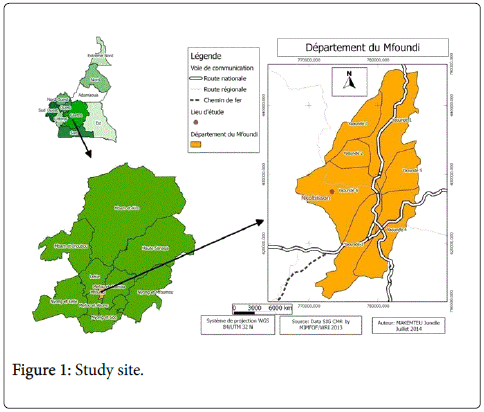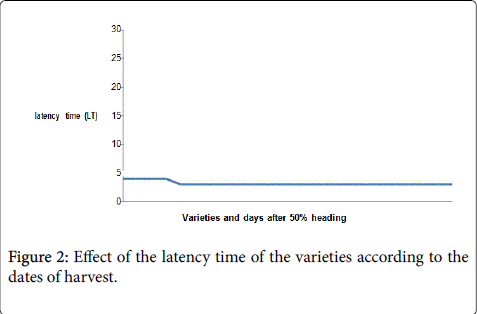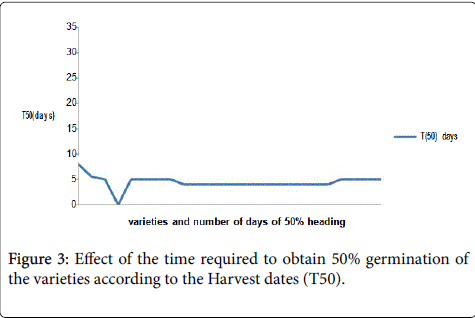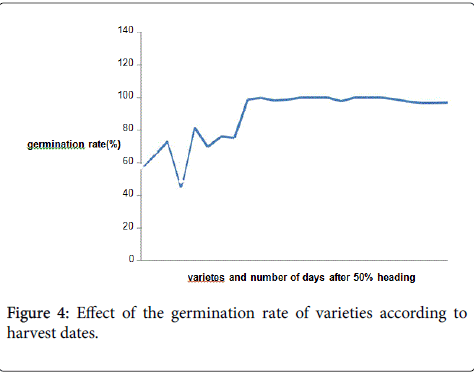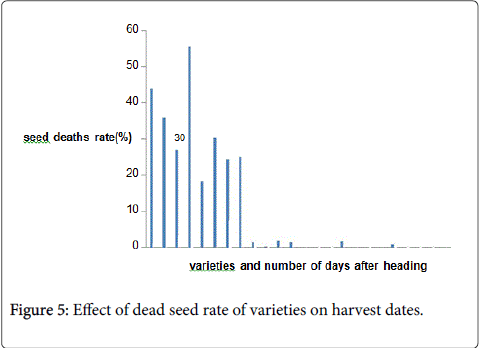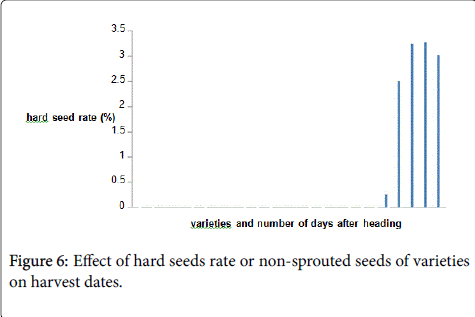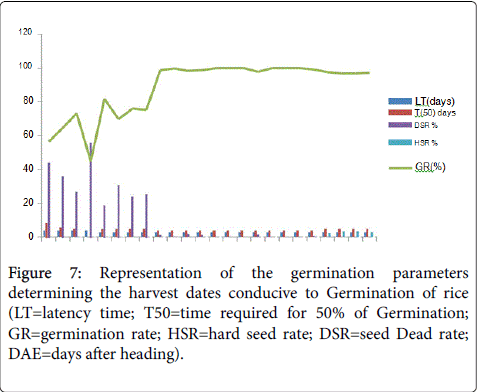Research Article Open Access
Harvest Date Influence on Seed Germination of Some Nerica Rainfed Rice Varieties
FMelie Feyem MN1,2*, Bell JM2, Malaa Kenyi D1, Fankou Dougoua MY1,2, Moche K1,2, Tandzi LN1, Mapiemfu Lamare D1,2, Likeng Lingue B2 and Woin Noe11Institute of Agricultural Research for Development (IRAD), BP 2123, Yaoundé, Cameroun
2University of Yaoundé I, BP 812 Yaoundé, Cameroon
- *Corresponding Author:
- Melie Feyem MN
Scientific and Technical Support
IRAD Agricultural Research Institute for Development
yaounde, Nkolbisson Yaounde VII
Yaounde, Center-237, Cameroon
Tel: +237699668290
E-mail: marienoelmeliefeyem@yahoo.com
Received date: 21 July, 2016; Accepted date: 22 December 2016; Published date: 3 January 2017
Citation: Feyem MMN, Bell JM, Kenyi DM, Dougoua MYF, Moche K, et al. (2017) Harvest Date Influence on Seed Germination of Some Nerica Rainfed Rice Varieties. J Rice Res 5:179. doi: 10.4172/2375-4338.1000179
Copyright: © 2017 Feyem MMN, et al. This is an open-access article distributed under the terms of the Creative Commons Attribution License, which permits unrestricted use, distribution, and reproduction in any medium, provided the original author and source are credited.
Visit for more related articles at Rice Research: Open Access
Abstract
The present study aims to determine the effect of harvest date on the germination of rice seeds. The experiment was carried out at Nkol bisson, a locality within the forest agro-ecological zone characterized by a bimodal rainfall pattern. Four varieties of NERICA: NERICA 3, NERICA 8, NERICA 9 and 13 NERICA widely grown in Cameroon were used and planted in a completely randomized block design. Rice seed was produced according to the standards of its production and were harvested at six different dates: 20, 25, 30, 35, 40 and 45 days after heading. The harvested seeds were dried at 13% moisture content. The results showed that the harvest dates have a significant effect on the latency, the time corresponding to 50% sprouted grains (T50), the number of sprouted grains, number of dead seed and the number of non-sprouted grains. There was significant difference between rice varieties evaluated and the different harvesting date. The germination rates 98.88%, 99.44%, 99.75% and 97.00% were obtained respectively for the harvest dates of 30, 35, 40 and 45 days after 50% heading. The harvest dates 20 and 25 days after 50% heading presented low germination rates. With these early harvesting dates, the mean percentages of dead seeds ranged between 18.25% and 55.25%. Too early harvest had a negative impact on rice seeds germination. To obtain good germination rate, it is recommend harvesting rice between the ranges of 30 to 40 days after 50% of heading.
Keywords
Rice; Seeds; NERICA; Harvest dates; Germination
Introduction
Rice (Oryza sp .) is the staple food for more than half of the world's population [1]. It ranks as the second cereal crop grown in the world after wheat [2]. In Africa, rice has become a very strategic and priority production food security. Consumption is rising faster than for any other major product on the continent due to the large population growth, the rapid urbanization and changing eating habits [3]. Although the local production of rice rose rapidly after the 2008 food crisis, a problem of the rice sector in Africa in general is that local production never equalled the demand. The continent therefore continues to depend on imports in order to meet the growing demand for rice [4] rice production in Cameroon's was 60,000 t in 2007 and satisfied only 10% of the national demand (600,000 t) as much rice is of high importance for food security [5].
In view of the existing potential and the weight of imports, the country must reverse the trend by the development of a strategy to promote rice cultivation in order to ensure competitiveness of this sector. However, one of the major constraints of improving the cultivation of rice is the lack of agricultural inputs [2], especially lack of quality seeds [6]. Seeds are an indispensable input for agricultural production. Moreover, neither productivity nor production can be improved without timely access to quality seeds [7]. Quality rice seeds will boost the production of consumer in order to reduce imports.
According to Law N° 2001/014 of July 23, 2001 on the seed activity, the seed is defined as the entire or part of an organ responsible for the reproduction and the perpetuation of the species.
Seed is the raw material of agriculture, which strongly influences the yield of any culture. Whether it is for a peasant variety or selected. Employment of quality seeds increases production by 10% to 15% [8]. A good seed must maintain the genetic purity of a variety, be healthy and well mature, have good germination ability, and be homogeneous in shape, seed size, and colour. Seed production is an important activity and appears to be the most important the first link in the agricultural sector [9], because it consists in setting up a production from seed stem to certified seed and provide quality seeds for producers. This requires care, more precision in procedures, more technical skills and strict production rules [9]. One of the most important technical rules in production is the harvest date [10].
The harvest date is the optimum harvesting time to obtain the best Seeds with high germination capacity [11]. It remains poorly known or almost not known by the seed multipliers of rain fed rice which is still new and booming in Cameroon. Seed growers are based on the panicles or the cycle of the plant sometimes disturbed by unstable climatic conditions, causing early or late harvests that have a negative impact on the ability of seed germination, resulting in loss of production in fields and the use of very high seedling materials. Germination is the first stage in the life cycle of plants to produce new generation, the ability of seeds to accomplish this biological process. The germination capacity is therefore an important characteristic for plant production.
The overall objective of this study is to contribute to the improvement of rain fed rice seeds quality to the production.
The specific objectives are to:
• Evaluate the influence of the harvest date on the germination of rice seeds NERICA;
• Compare the germination capacities of the varieties used;
• Determine the harvest dates favourable for a better germination capacity of rice seeds.
Material and Methods
Material
Study site: The present study was carried out on the site of IRAD Nkol bisson, located in the city of Yaounde, in the Central Region of Cameroon (Figure 1). Nkol bisson is located at 03° 51' north latitude and011° 27' longitude.
Plant materials: The plant materials used in our study consisted of four varieties improved rainfed rice seed base NERICA (new rice for Africa) From Africarice named NERICA3 (N3), NERICA8 (N8), NERICA9 (N9), NERICA13 (N13). These varieties are adapted in the study area and were adopted by the Participatory varietal selection during the introduction of NERICA varieties in Cameroon by the project of Improvement of the Competitiveness of Rice in Central Africa (Table 1).
| Varieties | Ecology | Cycle (days) | Yield (ha) |
| NERICA 3 | Upland | 100-110 | 03-Apr |
| NERICA 8 | 90-100 | 03-Apr | |
| NERICA 9 | 90-100 | 03-Apr | |
| NERICA 13 | 110-120 | 3,4,5 |
Table 1: Agronomic characteristics of varieties (IRAD).
Yaounde belongs to the agro-ecological zone V with bimodal rainfall. It is of the equatorial type (Yaoundeen), characterized by the alternation of two seasons dry and two rainy seasons. An average temperature of 23.5°C is recorded between 16°C and 31°C depending on the season and 1650 mm of water per year. The average humidity is 80% and varies in the day between 35% and 98%. Frequent winds are wet and blowing in the direction of the South-West; the strong winds are oriented towards the northwest. The vegetation is of the type Intertropical with predominance of the southern humid forest [12].
Production equipment: This is the field materials used for the production of seeds of different varieties of rice and agricultural inputs:
• The cutlass to clear the plot of production;
• Hoes for ploughing;
• Twine for sowing;
• A net to provide protection against birds;
• Fertilizers (20-10-10 200kg /ha and urea100 kg/ha.
Laboratory equipment: The laboratory equipment consisted of:
• Plastic plates in which the germination tests were carried out;
• A moisture meter for measuring humidity;
• Some water;
• Tissues paper to ensure moisture during the test.
Methods: Two activities were carried out:
• Seed production of selected varieties
• The germination test
Experimental design: The experimental design used to set up the trial was the blocks completely randomized with three repetitions.
Method of setting up the trial: The following operations permit to put our test in place:
• Preparation of the soil: The land had been cleared and ploughed from the first rains;
• Sowing: the sowing method used was hand - sowing in pockets at a rate of 3 to 5 grains per hole;
• One plant per hole was left three weeks later to leave after sowing;
• Spacing: The spacing was 25 cm in the line and 25 cm between the lines with a distance of one meter between the different plots.
Plot maintenance: The maintenance of the plot was as follows:
• Weeding: all the plots had been weeded three times and consisted of snatching all weeds in the field;
• Fertilizer application: each plot received fertilizer three times at a target stage of growth. The first application of fertilizer was 20-10-10 at 200kg/ha two weeks after sowing and second and third applications were made of urea at the initiation of panicles and meiosis at a rate of 50 kg/ha per application;
• Protection against birds: this was done by covering the field by a net and the recruitment of a labour to protect the trial;
• Purification: it consisted in removing all foreign varieties from the field in order to ensure the purity of seeds.
Harvest: The harvest dates were set up from the 50% heading of plants in each plot. Panicle harvests were carried out on each plot of land 20 days, 25 days, 30 days, 35 days, 40 days and 45 days after heading at 50% of plants.
Drying: The panicles were sprouted and the seeds dried to a moisture content of 13%. We went on to evaluate the germination of seeds from the different dates of harvest.
Germination test: The germination test was carried out according to the ISTA International Seed Testing Program). To make 400 seeds of each variety were seeded at the rate of 4 repetitions of 100 seeds per treatment. The substrate used is tissues paper and the method used is the top of the paper (TP). The germination test data observed for 14 days were:
• the date of observation of the first germination;
• the date of observation of 50% of sprouted grains;
• counting of germinated seeds;
• counting of non-germinated grains;
• And the counting of dead or rotted seeds.
These data enabled us to determine:
• latency time;
• The observation time of 50% germination (T50);
• the total percentage of germination;
• the total percentage of non-germinated seeds;
• The total percentage of dead or rotted seeds.
All of these data based on the average of the four replications of 100-seed had been entered in Excel. The analyses of the variances were carried out by the software SAS version 9.2, then the significantly different mean values separated by the Fischer test at the probability threshold of 5%.
Results
Influence of harvest time on the germination parameters of rice varieties
The results obtained during these tests clearly showed that the parameters of germination (latency time, T50, percentage of germination, percentage of dead or rotted seeds, and the percentage of non-germinated seeds) varied with harvest dates. Analysis of variance showed that there were highly significant differences between harvest dates and germination parameters studied on the one hand and significant differences between varieties used and the germination parameters on the other hand (Table 2).
| Sources of variation | DF | Means square | ||||
| LT (days) | T50 (days) | GR (%) | HSR (%) | SDR (%) | ||
| Varieties | 3 | 0 | 4,39* | 117,6* | 114,80 * | 0,09ns |
| Replications | 3 | 0 | 4,39ns | 21,47ns | 16,19ns | 0,59ns |
| Treatments | 5 | 2,7*** | 5,01*** | 4533,6*** | 4738,4*** | 23,81*** |
| Error | 0 | 1,24 | 37,14 | 36,47 | 0,62 | |
| Means | 3,16 | 4,5 | 88,41 | 11,08 | 0,51 | |
| Coefficient of variation | 0 | 24,71 | 6.89 | 54,49 | 153,43 | |
Table 2: Parameters for germination of rice varieties.***Very highly significant, probability less than 0.01*: Significant, probability less than 0.05. Ns: not significant. DF=degree of freedom; LT=latency time; T50=time required for 50% of Germination; GR=germination rate; HSD=hard seed rate; SDR=seed Dead rate.
Effects of harvest date on latency time (LT)
Analysis of variance showed that harvest dates had a significant time on latency. At 20 days after heading, the LT is 4 days and is 3 days at 25, 30, 35 and 40 days after heading (Table 2).
Effects of the harvest date on the time required to obtain 50 %( T50) of germination
The analysis of the results indicated that the harvest dates had an influence on the time necessary to have 50% germination. Indeed, the results showed that there was a significant difference between the times needed to obtain 50% germination for seed harvested at different harvesting dates. At 20 days after 50% heading, the T (50) is 7 days however it is 5 days to 25 and 45 days after 50% heading. However, it is 4 days when harvest is done at 30, 35 and 45 days after 50% heading (Table 2).
Effects of harvest date on germination rate (GR)
There was a significant difference between seed germination rates harvested at different harvesting dates. The dates of 30, 35, 40 and 45 days after 50% an average germination rate of 98.8%; 99.43%; 99.75% and 97% respectively. The dates of 20 and 25 days after heading presented the lowest germination rate with an average of 59.75% and 75.68% respectively (Table 2).
Effects of harvest date on dead seed rate (SDR)
Observations on dead seeds showed a significant in relation to seed harvest dates. At 20 and 25 days after 50% heading, the seed dead rate is high (40.25% for 20 days after 50% heading and 24.31% day after 50% heading). The analysis also showed that the rate of dead seeds decreases with harvest dates. Indeed, late harvest of seeds showed low rate of dead seeds.
Effects of harvest date on the rate of hard seeds or nongerminated seeds
The results showed that the rate of non-germinated seeds was zero at 20, 25, 30, 35 and 40 days after heading. From 45 days after heading, a low seed rate the average of non-germinated seed rate was 2.31% (Table 3).
| Parameters | Days after 50% heading | |||||
| 20 | 25 | 30 | 35 | 40 | 45 | |
| latency time | 4a | 3b | 3b | 3b | 3b | 3b |
| T50 | 7a | 5a | 4b | 4b | 4b | 5a |
| Germination rate | 59,75b | 75,68b | 98,87a | 99,43a | 99,75a | 97a |
| Seeds deaths rate | 40,25a | 24,31b | 1,12c | 0.57c | 0,25c | 0c |
| Hard seed rate | 0b | 0b | 0b | 0b | 0b | 3a |
Table 3: Mean squares of germination parameters at different dates harvest, a, b, c represent the germination parameters at 3 levels.
For each row the values of the germination parameters followed by the same letter are not significantly different at the 5% threshold.
Comparison of the germination capacities of the varieties used
The analysis of variance (Table 3) showed that there were significant differences( p<0.05) between the varieties used for some rice germination parameters, such as: T50, the percentage of germination and the rate of dead seeds at different harvesting dates, and differences not significant for the rate of non-germinated seeds.
Effect of the latency time of the varieties according to the dates of harvest
All varieties (N3, N8, N9, and N13) at 20 days after heading had a latency time of 4 days. This time decreases to 3 days at 25, 30, 35, and 40 days after headings for all the varieties of rice (Figure 2).
Effect of time required to obtain 50% germination of varieties in function of harvest dates (T50)
The observations made on the T50 showed highly significant differences for the varieties according to the dates of the seed harvest. All varieties at 20 days after heading had very high T50 values varying from one variety to another: 8 days for the N3, 5 days for the N8 and N9. At 25 days after heading the T50 decreases and reaches 5 days for all varieties. At 30, 35, 40 days after heading, the T50 decreases at 4 days to all varieties used. But at 45 days after heading, T50 goes back to 5 days for all varieties. The T50 of the N13 variety at 20 days is zero because the number of germinated seeds does not reach 50 during all observations (Figure 3).
Effectof the germination rate of varieties according to harvest dates
There was a significant difference between germination rates of varieties for different harvest dates. For all varieties, the germination rates do not varied too much. It ranged from 96.75% to 100% on the dates of 30, 35, 40 and 45 days after 50% heading. The date of 20 day after 50% heading showed the lowest germination rates between 44.75% and 75.25 for all varieties. N13 has the lowest germination rate followed by N3. At 30 days N8 had the highest germination rate of 99.75%. A 25 days after 50% heading, the N3 variety has a germination rate of 80%. At 45 days after 50% heading there was a slight decrease in the germination capacity for all varieties. This decrease of the germination rate is 2.5% for N3, 3.25% for N8 and N9 and 2% for N13 (Figure 4).
Effect of dead seed rate of varieties on harvest dates according to harvest dates
All varieties at 20 and 25 days after heading had a high rate of dead seeds (rate of rotten grains that have not germinated but pressed with the finger reveals a paste) between 55.25% and 45.5%. This rate decreases for all varieties and is almost zero at 30, 35, 40 and 45 days after heading for all varieties of rice (Figure 5).
Effect of the rate of hard seed or non-sprouted seed of varieties in based on harvest dates
All varieties had zero non-germinated seeds at 20, 25, 30, 35 and 40 days after heading. From 45 days after heading, we observed a low hard seed rate that means an ungerminated seeds for all varieties. This rate is 2.5% for N3, 3.25% for N8 and N9 and 3% for N13. There was no significant difference between rates of non-sprouted seeds and varieties used (Figure 6).
Determination of the right time for harvesting seeds rice of varieties
According from previous results, dates for harvesting seeds of all varieties of rice are: 30, 35 and 40 days after heading. These dates correspond to the dates with short latency time, short T50, germination rate high, low seed rate. The date of 45 days after heading has a time of latency identical to that of 20 days after heading, a slight decrease in the germination rate compared to 30, 35 and 40 days after heading and about 3% of non-germinated seeds. For these reasons, this date cannot be considered as a favourable date for the harvest of all the varieties (Figure 7).
Discussion
The results obtained in this study showed that there were a highly significant difference between harvest dates and germination parameters. The germination rate increases with harvest dates. The dates of 20 and 25 days after heading showed an average germination rate of 59.75% and 75.68% respectively, while the dates of 30, 35, 40, 45 days after 50% heading showed an average of the germination rates of 98.8%; 99.43%, 99.75% and 97%, respectively. This result was similar to the own founded by Sallam et al. [13] who demonstrated that the germination rate of Teosintes increases with harvest dates and reaches 70% to 40 days after flowering. Similarly, Ofori and al. [14] conducted a study on beans and founded that 30 and 35 days after opening flowers the germination rate was 88% whereas at 20 days it was only 43.5%. The dates of harvesting with high germination rate values had short latency time values and T (50), which was 3 and 4 days respectively [15]. The T (50) expresses the rate of germination, responsible for the depletion of seed reserves [16]. At 45 days after heading we observed a slight decrease in the rate of germination which is 97%, the latency time is the same at 30, 35 and 40 days but the T50 increase and rich 5 days as for 20 and 25 days after heading. We also observed non germinated hard seeds reaching a rate of 3.25%. This marks the beginning of the deterioration of the seeds which is manifested by the diminution of the germination capacity of the seed [17]. Envelope seed coats may have become resistant and thus no longer able to absorb the water of imbibition which must determine their development following the various metabolic activities that will occur within them [18]. This marks the entry into dormancy of rice seed resulting on the hardening of the teguments no longer allowing the penetration of water. According to Akintayo et al. [8] in the Practical Guide of NERICA upland Culture, when rice seeds remain long in the field after maturity, they fall into dormancy to prevent germination on the panicles.
Our study showed that there were also significant differences between varieties and the germination parameters according to different harvest dates. For each date of harvest, some germination parameters (T (50), percentage of germination) varied from one variety to another. These variations were much more pronounced at 20 and 25 days after 50% heading. On these dates the values of the T (50) was very high: 8 days for the N3, 5 days for N8 and N9 and zero for N13 because the number of germinated seeds does not reach 50 during all observations. These variations are due to variations in crop cycles of the different varieties, it is noted that the longer the cultivation cycle the longer the period of 50% germination at 20 and 25 days after heading. This values decreases with the increase in harvest days and thus 30, 35, 40 days after heading the T50 decreases again and stabilizes at 4 days for all varieties also. The germination rates differ from one variety to another, the N13 variety shows the lower rate of germination followed by N3. At 30 days N8 showed the highest germination rate of 99.75%. At 25 days after 50% heading, the N3 variety had a germination rate of 80%. AT 30, 35, and 40 days after heading, the T (50) and germination rate values stabilized. All these results are justified by the fact that rice varieties differ only in vegetative phase, the reproductive and ripening phases being relatively fixed and included between 30 and 35 days regardless of the variety [19]. At 45 days after 50% headingT50 back to 5 days for all varieties. It is also observed at 40 days after 50% heading a low rate of nongerminated seeds for the N13 varieties in contrary to the varieties that are observed at 45 days after heading with rates reaching 3.25% this marks the beginning of seed deterioration. The phenomenon of deterioration and Seed dormancy is more prevalent for NERICA13.
Seeds from panicles harvested at 20 and 25 days after heading had a latency time and T50 long because the germination rate responsible for the depletion of seed is low. This explains their low germination rates and high rates of seed deaths. This may be due to the fact that the grains have not reached physiological maturity from where the low quantities of seed reserves that of germination. Such seeds are not accepted by standards of seed production because they cannot be classified as quality seed [20]. For panicles harvested at 30, 35 and 40 days after heading have latency and a short T50 (3 and 4 days, respectively). The germination rate of the seeds from these panicles is between 95% and 100% for all varieties which characterize high quality seed. High quality seed has a direct effect on production because it allows not only the use of the most economical seeding rates, but also better emergence rates in the field, better uniformity of plants, maturity and production [21]. These results also correspond to the minimum legal standards set in Cameroon by decision No 540 / MINADER / SG / DRCQ / SDRSQV OF 07 SEPTEMBER 2006 and applied by the Direction of Regulation and Quality Control of Agricultural Inputs (DRCQ) in order to declare rice seed as quality seed [22]. The best harvesting date to obtain good germination rate of seed for the evaluated varieties is between 30 and 40 days after heading [23].
Conclusion
This study aimed to study the influence of the harvest date on the rice seeds germination rate. It appears that the dates of harvest strongly influence the germination parameters. The germination rate increases with harvest date with an average of 59.75; 75.68; 98.87; 99.43 and 99.75% respectively to 20, 25, 30, 35 and 40 days after heading. At 45 days after heading this germination rate starts to decline and reaches 97%.
The varieties of rice used showed a significant difference in the parameters of germination according to the harvest date. At all harvest dates, the values of germination parameters varied according to the varieties. At 30, 35, 40 days after heading these values are between 98% and 100%.
Seeds from the panicles of harvested at 30, 35, 40 days after heading had germination rates that correspond to the minimum legal standards to be reached so that the seeds of rice are accepted as good quality seed. These dates indicate the right moment for harvesting all the varieties of rice used in this study. Early harvesting negatively influence the germination rate of rice seeds. Harvesting at the right time allows maintaining seed dormancy within the required limits.
Recommendation
For good germination and good quality seed of rice varieties N3, N8, N9, N13, it is recommended to harvest between 30 and 40 days after 50% of headings.
Acknowledgement
This work received the financial support of the C2D-PAR-RIZ.
References
- Pompidou DF (2014) Boosting local rice production to boost food security in Northern Cameroon. J ApplBiosci 2: 7449-7459.
- Osanyinlusi OI, Adenegan KO (2016) The determinants of rice Farmers’ productivity in Ekiti state, Nigeria. Greener Journal of Agricultural Sciences 6: 049-058.
- Seck PA, Diagne A, Mohanty S, Wopereis MCS (2012) Crops that feed the world 7: rice. Food Sec 4: 7-24.
- Macauley H, Ramadjita T (2015) Cereal crops: rice, maize, millet, sorghum and wheat. Africa Rice Center, Benin p: 38.
- Anonyme (2008) National Rice Development Strategy in Cameroon. MINADER Yaoundé p: 21.
- Anonyme 11 (2013) Fact Sheet No. 2 certified improved seed production techniques. Bamako p: 4.
- Aminou A, Aliou D (2013)mpact of rice seed production on farm household yield: A case study of Benin. Africa Rice Center (AfricaRice) Benin p: 17.
- Akintayo I, Cisse B, Zandji LD (2008) Practical Guide to NERICA Plateau Culture. Africa Rice Center (Africa Rice) (ADRAO) Benin p: 36.
- Anonyme 3 (2012) Guide to Rice Seed Production. Republic of Mali p: 14.
- Sidi Med OD (2014) Conducting the cultivation of rice (Oryzasativa) for seed production. Professional license memoir in production and plant protection. Higher Institute of Technological Education of peso p: 37.
- Angladette A (1966) Rice. Editions G-P Maisonneuve and Larousse, Paris, France p: 930.
- Wethé J (2001) Use of macrophytes for domestics waste water treatment in developing countries. 25eme journéescientifique en sciences et techniques de l'environnement. Université Paris 12, ENPC, CEREVE, Paris.
- Sallam AM, Ibrahim HIM (2014) Effect of Harvest Time on Yield and seed Quality of Teosinte. American-Eurasian J Agric Environ Sci 14: 1159-1164.
- Ofori K, Klogo PY (2005) Optimum Time for Harvesting Yearlong Bean (Vignasesquipedalis) for High Yield and Quality of Pods and Seeds. Journal of Agriculture & Social Sciences 1: 1813-2235.
- Benamar B, Bouâmama K, Meriem KH, Florence D (2010) Study of the germination and the effect of the substrate on the growth of young seedlings of pistaciaveral. Málaga. ActaBotanicaMalacitana 35: 107-114.
- Mrani A, Jourmi LE, Ouarzane A, Lazar S, Antri SE, et al. (2013) Effet du stress salinsur la germination et la croissance de six variétésmarocaines de blé 4: 997-1004.
- Aya A NNDRI, Vroh IBI, Kouamé PL, Irié A, Zoro BI (2011) Genetic and biochemical bases of seed germination capacity: implications for seed systems and food production. Sciences & Nature 8: 119-137.
- Juliette D, Kouassi A (2015) Study of the germinative power of four varieties of rice GIZA 178, WAB 56 - 50, LOHININI, DANANE and identification of fungi present on seeds in germination. Africa Science 11: 161-171.
- Wopereis MCS, Toon D, Philip I, Salif D, Marie JD (2008) Participatory Learning Curriculum and Action Research (APRA) for Integrated Management of Lowland Rice Crop (GIR). Sub-Saharan Africa p: 50.
- Lacharme M (2001) Issue 10. Certified seed production Operating rules p: 11.
- Renou C, Kambale JM, Lindiro R (2014) Production of rice seed training guide. The international fertilizer development center, Albama p: 74.
- Anonyme 12 (2006) Approving the official technical regulations for the production of seed control and certification of some cereals (but composite but hybrid, rice and free-flowing sorghum)p: 9.
- Lacharme M (2001) Issue 2. The rice plant. Memento technique of rice cultivation. Ministry of Rural Development and Environment p: 21.
Relevant Topics
- Basmati Rice
- Drought Tolerence
- Golden Rice
- Leaf Diseases
- Long Grain Rice
- Par Boiled Rice
- Raw Rice
- Rice
- Rice and Aquaculture
- Rice and Nutrition
- Rice Blast
- Rice Bran
- Rice Diseases
- Rice Economics
- Rice Genome
- Rice husk
- Rice production
- Rice research
- Rice Yield
- Sticky Rice
- Stress Resistant Rice
- Unpolished Rice
- White Rice
Recommended Journals
Article Tools
Article Usage
- Total views: 6280
- [From(publication date):
March-2017 - Jul 02, 2025] - Breakdown by view type
- HTML page views : 5160
- PDF downloads : 1120

